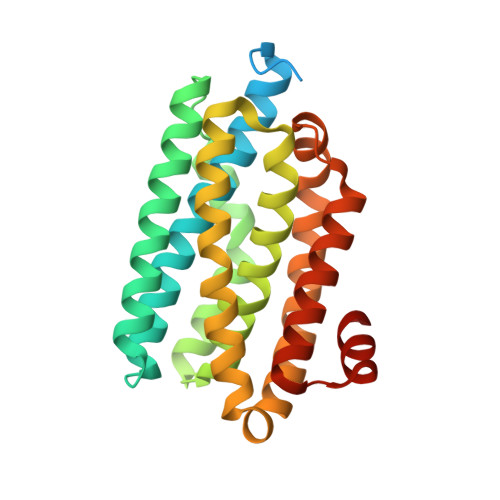Crystal structures of aldehyde deformylating oxygenase from Limnothrix sp. KNUA012 and Oscillatoria sp. KNUA011.
Park, A.K., Kim, I.S., Jeon, B.W., Roh, S.J., Ryu, M.Y., Baek, H.R., Jo, S.W., Kim, Y.S., Park, H., Lee, J.H., Yoon, H.S., Kim, H.W.(2016) Biochem Biophys Res Commun 477: 395-400
- PubMed: 27329814
- DOI: https://doi.org/10.1016/j.bbrc.2016.06.090
- Primary Citation of Related Structures:
5K52, 5K53 - PubMed Abstract:
The cyanobacterial aldehyde deformylating oxygenase (cADO) is a key enzyme that catalyzes the unusual deformylation of aliphatic aldehydes for alkane biosynthesis and can be applied to the production of biofuel in vitro and in vivo. In this study, we determined crystal structures of two ADOs from Limnothrix sp. KNUA012 (LiADO) and Oscillatoria sp. KNUA011 (OsADO). The structures of LiADO and OsADO resembled those of typical cADOs, consisting of eight α-helices found in ferritin-like di-iron proteins. However, structural comparisons revealed that while the LiADO active site was vacant of iron and substrates, the OsADO active site was fully occupied, containing both a coordinated metal ion and substrate. Previous reports indicated that helix 5 is capable of adopting two distinct conformations depending upon the existence of bound iron. We observed that helix 5 of OsADO with an iron bound in the active site presented as a long helix, whereas helix 5 of LiADO, which lacked iron in the active site, presented two conformations (one long and two short helices), indicating that an equilibrium exists between the two states in solution. Furthermore, acquisition of a structure having a fully occupied active site is unique in the absence of higher iron concentrations as compared with other cADO structures, wherein low affinity for iron complicates the acquisition of crystal structures with bound iron. An in-depth analysis of the ADO apo-enzyme, the enzyme with substrate bound, and the enzyme with both iron and substrate bound provided novel insight into substrate-binding modes in the absence of a coordinated metal ion and suggested a separate two-step binding mechanism for substrate and iron co-factors. Moreover, our results provided a comprehensive structural basis for conformational changes induced by binding of the substrate and co-factor.
Organizational Affiliation:
Division of Polar Life Sciences, Korea Polar Research Institute, Incheon 21990, Republic of Korea.
















